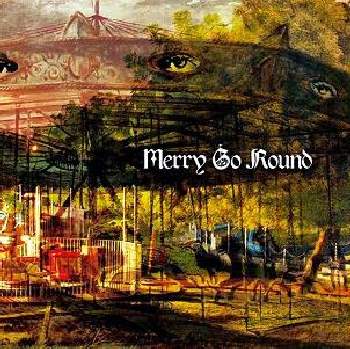Merry Go Round from Pisa in Italy describe themselves as a psychedelic progressive rock band with wild rhythm and blues touches. Most of the band's members have been playing together s ince the late 80s, partly in a band called Storks, partly (Michele Profeti and Stefano Gabbani) in Standarte, who delivered three well received albums in the 1990s. In 2012 they reassembled, and formed Merry Go Round, adding Sandro Vitolo and Martina Vivaldi to the line-up. Their self titled debut was released on vinyl and on CD, with Friday The 13th as a bonus track on the latter. From the description given of the band's music in their bio, vintage keyboards and dueling guitars are the prominent elements of their music - and that shows from the first track onward. The intro to Dora's Dreams has a mad keyboard tune and guitar underneath that immediately remind of PFM's E Festa. However, where that track keeps the tempo and pulse going to the end, Dora's Dreams slows down in the gloomy vocal parts, where vocalist Martina Vivaldi is in charge. She has a voice that fits the music, but also takes some time getting used to. She wouldn't be out of place in an 80s female fronted metal band, but blends in nicely with the sound of Merry Go Round as well. The guitars and keyboards stay dominant indeed, on the slower and less gloomy sounding After (with lyrics that are still dark - 'let me walk around my funeral pire'), and the rocking Autumn's Days and Poison Ivy. On Free Ride, the guitars are more dominant than the keyboards for a change, making this into a 70s like hard rock track with an edge. The mix of guitar and keyboards (mainly the Hammond organ) returns on pulsating The Changeling, which at some point made me wonder if I was listening to a Uriah Heep cover. The same recognizable sound, with a touch of early Deep Purple organ work can be heard on In Search Of Lost Time. This way, the album brings almost an hour of keyboard and guitar driven music, which will cer tainly make vintage keyboard fans and 70s hard rock fans quite happy. I can enjoy this too, but at the same time, it was a bit too much of the same. Partly due to the fact that the album seems to lack 'quiet' moments, there's a wall of sound from beginning to end. The only exceptions to this are the track To Die Of Fear, which mixes organ and acoustic guitar, resulting in a much quieter atmosphere than the other tracks - but here the vocals are still quite loud (at some point they even seem to clip). A bit more variation in volume (or a less loud production) might benefit the band and make their music, which is certainly of a high standard, more appreciable to listen to. To close on a positive note, the high standard shows in the hidden track, which comes in after 30 seconds of silence at the end of Friday The 13th. This appears to be a live recorded jam, or at least it sounds as if it is - with massive organ work, a funky guitar (and some great solos), and a booming bass. This band rocks, and deserves a good listen, but the album is a bit too loud for my ears to play in one go. *** + Angelo Hulshout (edited by Astrid de Ronde) Where to buy? |
